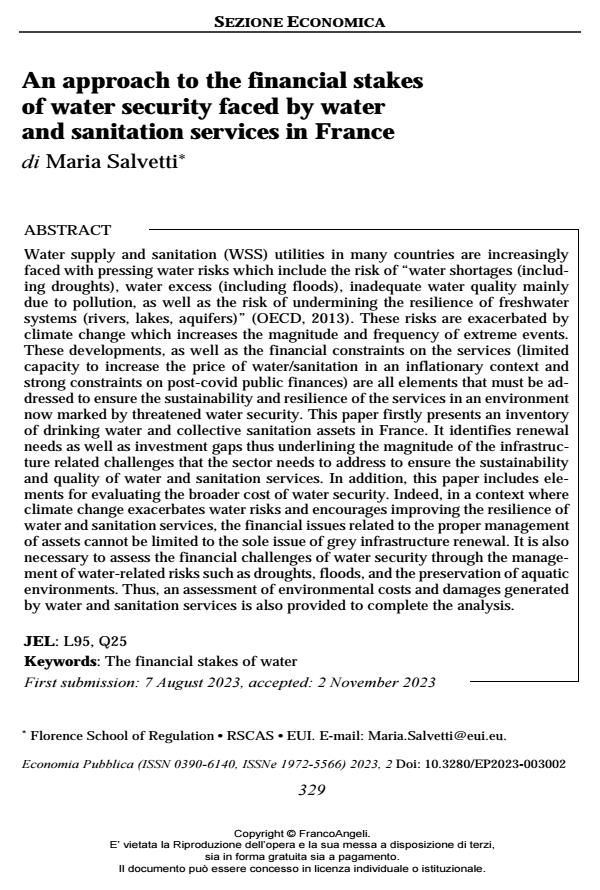An approach to the financial stakes of water security faced by water and sanitation services in France
Journal title ECONOMIA PUBBLICA
Author/s Maria Salvetti
Publishing Year 2024 Issue 2023/3
Language English Pages 27 P. 329-365 File size 387 KB
DOI 10.3280/EP2023-003002
DOI is like a bar code for intellectual property: to have more infomation
click here
Below, you can see the article first page
If you want to buy this article in PDF format, you can do it, following the instructions to buy download credits

FrancoAngeli is member of Publishers International Linking Association, Inc (PILA), a not-for-profit association which run the CrossRef service enabling links to and from online scholarly content.
Water supply and sanitation (WSS) utilities in many countries are increasingly faced with pressing water risks which include the risk of “water shortages (includ- ing droughts), water excess (including floods), inadequate water quality mainly due to pollution, as well as the risk of undermining the resilience of freshwater systems (rivers, lakes, aquifers)” (OECD, 2013). These risks are exacerbated by climate change which increases the magnitude and frequency of extreme events. These developments, as well as the financial constraints on the services (limited capacity to increase the price of water/sanitation in an inflationary context and strong constraints on post-covid public finances) are all elements that must be ad- dressed to ensure the sustainability and resilience of the services in an environment now marked by threatened water security. This paper firstly presents an inventory of drinking water and collective sanitation assets in France. It identifies renewal needs as well as investment gaps thus underlining the magnitude of the infrastruc- ture related challenges that the sector needs to address to ensure the sustainability and quality of water and sanitation services. In addition, this paper includes ele- ments for evaluating the broader cost of water security. Indeed, in a context where climate change exacerbates water risks and encourages improving the resilience of water and sanitation services, the financial issues related to the proper management of assets cannot be limited to the sole issue of grey infrastructure renewal. It is also necessary to assess the financial challenges of water security through the manage- ment of water-related risks such as droughts, floods, and the preservation of aquatic environments. Thus, an assessment of environmental costs and damages generated by water and sanitation services is also provided to complete the analysis.
Keywords: The financial stakes of water
Jel codes: L95, Q25
Maria Salvetti, An approach to the financial stakes of water security faced by water and sanitation services in France in "ECONOMIA PUBBLICA " 3/2023, pp 329-365, DOI: 10.3280/EP2023-003002